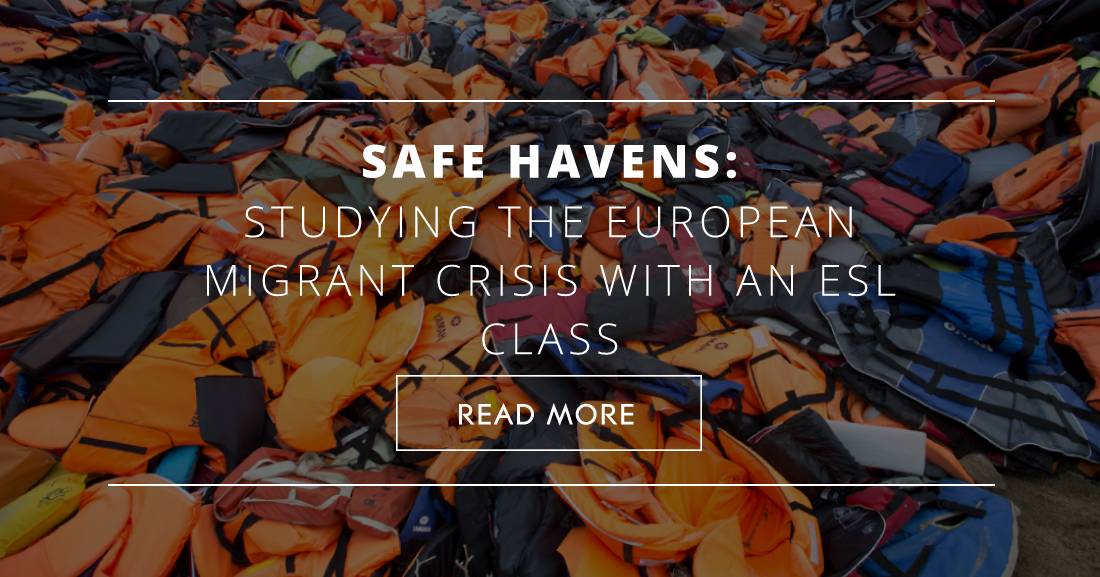The Echo Chamber: An ESL Lesson on 21st Century News Media


My academic director is an enlightened pedagogical superstar, my students are bright, curious young people from all over the world, and I’m given a huge amount of latitude in the classroom, even to the extent of designing my own courses and content. This has been a professional privilege, and also a priceless opportunity to experiment and develop new content and methods.
I’ve also been encouraged to develop a ‘Contemporary Topics’ syllabus which is flexible and can be tailored to the interests of the class. I have students from the Middle East and north Africa, as well as France and the Balkans, so it made sense to examine the European Migrant Crisis with my advanced class. Here’s how we tackled the topic, as well as some links and guidance to help you develop your own approach:
At the risk of sounding like a broken record, I’ll reiterate the importance of asking your students to explain the overall situation, rather than telling them. The basic reason for this is that they already understand the crisis (unless they’re truly news-averse, and right now, their being unaware of the Migrant Crisis is as unlikely as their failing to recognize Donald Trump) and need only a little help to explain it. I recorded the class, as usual, and here’s how we began:
| Teacher: | [Showing pictures and clips of migrants in Europe, and being rescued from the Mediterranean.] Can you imagine a life as difficult as that? |
| Students: | [Shaking heads.] Is terrible / So many people / Breaks my heart. |
| Teacher: | Mine too. Let’s think about this. Where have they come from? [Open gesture to elicit individual answers] |
| Students: | Muslims / Syria / War places / Violent places |
| Teacher: | Exactly. Syria is the number one point of origin [writes this on the board]. But where else have they come from? |
| Student 3: | Afghan? |
| Student 2: | Many Muslim countries. |
| Teacher: | How about a country which begins with ‘I’ and has so many problems these days? |
| Student 2: | Iran? |
| Teacher: | (Laughing) The other one… |
| Student 1: | Iraq. Is terrible there. So many violence. |
| Teacher: | And who is creating the violence? |
| Students: | ISIS / Daesh / Crazy terrorists / The government? |
Alright, so we had some gaps to fill in, but my students were aware of the migrants’ points of origin, and as I found out a little later, the reasons for their flight:
| Student 2: | But some of them just have no job, and want a job in Germany or somewhere. |
| Student 3: | But there are no jobs where they live. They need help. |
| Teacher: | In some cases, there is not even government where they live. No economy at all. Can we understand why they’d want to leave? |
| Students: | Yes / Of course / Leaving is difficult. |
| Teacher: | But it’s risky, isn’t it? |
| Student 5: | Very dangerous journey. On boat… no, by boat, right? |
| Teacher: | By boat, yes, but what kind of boats? |
| Students: | Risky / Dangerous / Tiny / Maybe sinking in the water. |
In quick, short sections of dialogue like this, we established the main reasons migrants leave their homes. Eventually, we had a list on the board which included:
I also made sure we reviewed and practiced the words asylum, residency, application and refugee, as well as quickly reviewing which countries belong to the Shengen Area of the EU, which permits relatively easy travel between European countries.
If faced with this topic ten years ago, I’d probably have prepared a presentation, complete with PowerPoint slides, to show my students what’s going on. But these days, I think differently. It’s not that I’m getting lazy in my middle age; instead, I have found perfectly good reasons to have my students do most of the legwork, research and reading. I had a colleague once who told me I was being too trusting, and should probably just feed in the information myself; I reminded him that my research, presentation and English skills are just fine, and that I wasn’t the one who needed practice!
I also like creating opportunities for my students to surprise me, and as a result of taking these minor risks, I’ve been learning that my students’ research skills are of a higher order than many might expect, and that I can rely on them to find good data (especially if I give them some hints as to appropriate sources).
Possible topics for research and presentations include:
When discussing fascinating subjects like these, it’s tempting to focus on the content and relegate the language aspects to the status of ‘nice to have’. I’m becoming more aware of this trap, and my lesson plans have evolved ‘markers’ to remind me of the target language and structures so that I’m always eliciting them and listening out for their accurate use and pronunciation.
The best way to practice the new language is to provide the students with a platform for basic discussion (through research, so they understand the basics) and then provide a reason to use the language (through debate and more advanced, detailed discussions relating to the topic). I try to wring out every chance to use new words and help students absorb new vocabulary into their long-term memories; the best way, I’ve found, is to include a final ‘free practice’ exercise which moves us away from teacher-student interaction and involves a reliance on independence and fluency. Try one or more of these exercises to get the best from this topic:
Under the surface of my classes - never in the lesson plan, but in the background all the same - are opportunities to practice life skills which are especially hard-won: empathy, tolerance, compassion, forgiveness and plain, old-fashioned love. I’m a teaching professional, but I’m also a concerned, engaged citizen who has worries about the future; tiny acts of encouragement can meaningfully change the way our students think, and when discussing migration, a little empathy and understanding will go a long way.